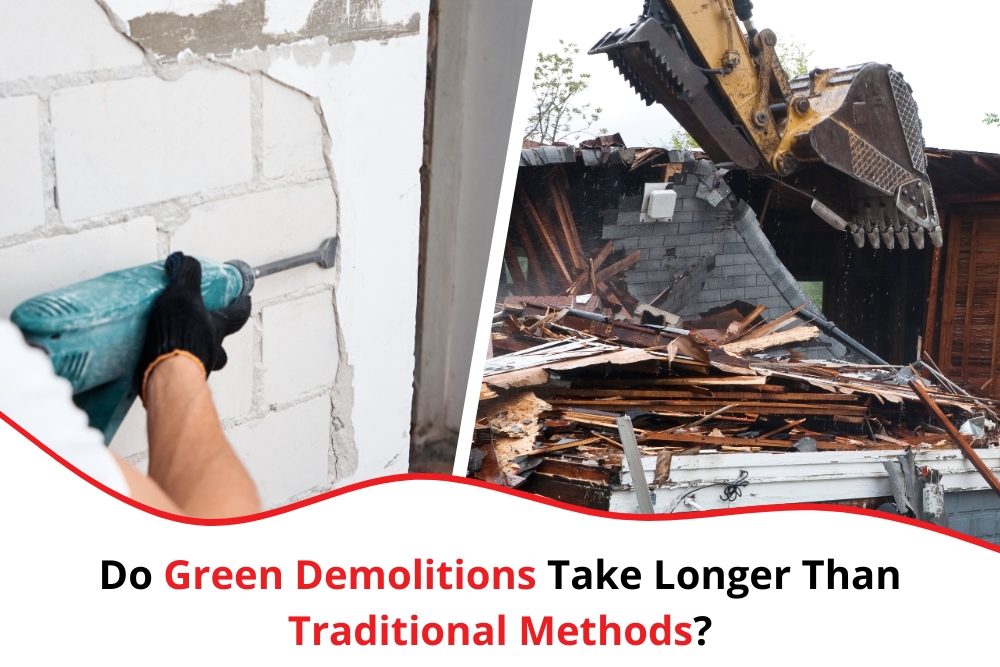Thinking about knocking down a building? While the idea of a fresh start is pretty sweet, figuring out how to actually demolish the old place can feel like a headache. One big decision is what kind of demolition to go for. Here are the two main options: traditional and green demolitions (also called deconstruction).
What are green demolitions?
A green demo is all about being kind to the environment. Instead of smashing everything down (think bulldozers and wrecking balls!), the green demo carefully takes the building apart. This lets them:
- Snag awesome stuff: Doors, windows, even timber – they save all the good bits to be used again in new projects.
- Recycle what they can’t reuse: Instead of becoming landfill decorations, concrete and bricks get a makeover!
- Keep the rubbish out of the landfill: A big win for the environment!
How do green demolitions differ from traditional demolition?
Traditional demolition and green demolition might seem like they achieve the same goal – taking down a building. But the way they go about it is as different as night and day. Here’s a breakdown of the key differences:
Traditional demolition:
- Method: Think brute force. Big, loud machines like excavators and wrecking balls turn the place into rubble in a flash.
- Materials: Anything that can’t be easily separated gets tossed into a giant dumpster destined for the landfill.
- Focus: Speed and cost-effectiveness are king. The goal is to clear the site quickly and cheaply for the next development phase.
- Sustainability: This is not a significant concern. Traditional demolition sends a lot of stuff to landfills, which could be a more on-trend trend in sustainable waste management in Australia.
Green demolition (deconstruction):

- Method: This is a meticulous, hands-on approach. Skilled workers carefully dismantle the building piece by piece, sorting materials for reuse or recycling.
- Materials: Think treasure hunt! Doors, windows, timber, bricks, concrete – anything with a second life gets meticulously salvaged.
- Focus: Environmental responsibility and resource recovery. The goal is to minimise waste and divert as much material as possible from landfills, promoting responsible construction and demolition waste management.
- Sustainability: A core principle. Green demolition aims to give building materials a new lease on life, reducing environmental impact.
Think of it this way: Traditional demolition is like throwing away a perfectly good toolbox because you need the hammer. On the other hand, green demolition involves carefully disassembling the toolbox and salvaging the hammer and other useful tools for future projects.
How does the time investment differ between green demolition and traditional demolition?
Traditional demo? Picture a demolition derby! Wrecking balls swing, bulldozers roar, and the building vanishes in a dust cloud. It’s fast and furious, for sure. This is the quick and frantic world of traditional demolition. A small house could be rubble in 2-5 days, with even larger projects taking only a few weeks.
Green demolition, on the other hand, is more like a meticulous treasure hunt. Skilled workers carefully remove and sort materials, giving each item a chance at a second life. This careful approach naturally takes longer. Expect green demo projects to take anywhere from 7 to 10 days for a typical house and even longer for complex structures with a lot of salvageable materials.
Here’s a breakdown to keep in mind:
- Small house:
- Traditional demolition: 2-5 days
- Green demolition: 7-10 days
- Large building:
- Traditional demolition: Up to a few weeks
- Green demolition: 10 days or more (depending on complexity)
But remember, speed isn’t everything! While traditional demolition might get the job done quickly, the extra time invested in green demolition has some hidden benefits.
What are the long term benefits of green demolitions?
While a green demo takes a bit longer upfront, it has some excellent long-term benefits:
- Save the planet! Less waste in landfills means a happier Earth.
- Save some cash! Those salvaged materials can be sold or reused in your new project, saving some serious coin.
- Support your mates! Green demo uses skilled workers and often supports local businesses specialising in recycling materials.
Deconstructing a building lets you salvage a bunch of stuff instead of just tossing it all in the trash. Learning to recycle materials during your demo project can turn you into a demolition recycling pro!
When might traditional demolition be a faster option?
While green demolition offers a treasure trove of environmental and potential financial benefits, there are situations where traditional demolition might be the better option. Here are some key times when speed trumps meticulous deconstruction:

- Safety first! If a building is a potential danger zone – think asbestos contamination, structural instability, or fire hazards – a swift and controlled demolition might be the safest course of action. Traditional demolition speed allows for quicker removal of the building, minimising risk to workers and the surrounding area.
- Budgeting tightrope walk: Budgets are a reality. Traditional demolition often has a lower upfront cost compared to green demolition. This can be a deciding factor, especially for smaller projects or those with tight financial constraints.
- Deadline dash: Sometimes, time is of the essence. You may need the site cleared for new development with a strict deadline, or there are legal requirements for a speedy demolition. In these cases, traditional demolition’s rapid pace can be crucial for staying on schedule.
Choosing the proper demolition method for your project
The best demolition method depends on your specific project:
- What’s your goal? Speed or saving the planet? This will guide your decision.
- Money matters! Weigh the upfront cost against potential savings from salvaged materials.
- Local laws? Check local regulations that might influence your demolition method.
Conclusion
Green demolition takes a bit longer overall. But, consider the long-term benefits, like a healthier planet and potential cost savings, and weigh them against the initial investment.
Get your free demolition consultation
Demolition decoded! Feeling confident about your project yet? At Watson Demolition & Site Services, we’re the traditional demolition experts in Newcastle. We’ll get the job done quickly and responsibly, with a crew that knows their stuff. Want to chat about making your demo project a breeze? Talk to Watson Demolition & Site Services today for a free consultation! Let’s turn your demolition dream into a reality.



